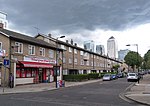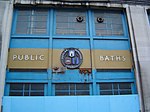South Bromley railway station
Disused railway stations in the London Borough of Tower HamletsFormer North London Railway stationsPoplar, LondonRailway stations in Great Britain closed in 1944Railway stations in Great Britain opened in 1884 ... and 1 more
Use British English from February 2017
South Bromley railway station was a former railway station in South Bromley, London, on the North London Railway between Bow and Poplar (East India Dock Road). It opened in 1884 but was closed in 1944 after bomb damage in the Blitz cut off the railway east of Dalston Junction.
Excerpt from the Wikipedia article South Bromley railway station (License: CC BY-SA 3.0, Authors).South Bromley railway station
Rifle Street, London Poplar
Geographical coordinates (GPS) Address Nearby Places Show on map
Geographical coordinates (GPS)
| Latitude | Longitude |
|---|---|
| N 51.5169 ° | E -0.0147 ° |
Address
Rifle Street 11
E14 6FH London, Poplar
England, United Kingdom
Open on Google Maps










